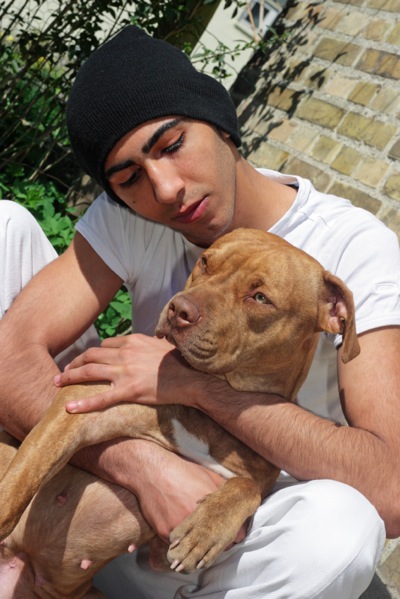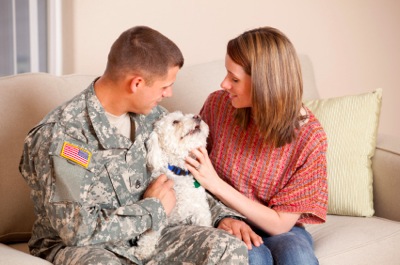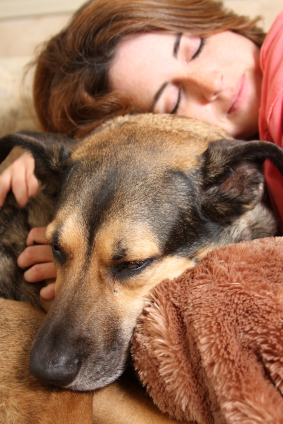You’ve done your research, budgeted for a new pet, visited animal shelters, found the perfect pet – and now you’re ready to bring your adopted pet home. However, your job as a pet parent is just beginning. You need to prepare your home and family to help minimize your pet’s stress and make it easier for him to adjust to his new life.
Like children, pets need structure and consistency, and will thrive in an environment where they know what is or is not permissible. Providing a good home for a companion pet involves commitments to bonding, structure and discipline, quality care, safety and sustenance – and of course, love. Lots of it.
Preparing your home and family
- Ask shelter staff if your pet has any known allergies so that you can eliminate the allergens from your home.
- Know how you will transport your pet home from the shelter – in a crate, pet care seat or other conveyance.
- Choose a spot for your pet’s food and water bowls, ideally in an area that is not heavily trafficked or subject to a lot of distractions. Some pets, particularly dogs, are anxious if others are too close to their food bowls when they are eating.
- Similarly, decide where your pet will sleep (your bedroom, the kitchen) and in what she will sleep (crate, pet bed).
- Set aside a quiet room where your pet can go if she feels overwhelmed or anxious.
- If you are adopting a senior pet or an animal with physical disabilities, make sure there are plenty of comfortable resting spots or multiple beds she can access. Be mindful that she might not be able to navigate stairs or hard floors easily.

- Agree on whether your dog or cat will be permitted on the furniture.
- For cats, figure out all things litter box: where it will be located, who is responsible to clean it and how often, and whether you will have more than one throughout your home.
- Decide who will be responsible for walking the dog. If there are multiple walkers in your household, you might want to post a schedule in a common room, like the kitchen. Once your dog is home and you can assess his activity level and needs, you may need to adjust the schedule to include more walks, or fewer.
- Have a plan for where your dog will be when you are not at home. Will she have free reign of the house, be gated in one particular area, go to doggie daycare or have a pet sitter visit? Similarly, have a plan for when you go on vacation or expect to be away for any overnight period.
Training
- Have a set vocabulary for commands so as not to confuse your pet. Will you say “paw” or “shake hands?” “Down” or “lay down?”
- Discuss the merits of crate training, and brush up on crate training basics before you bring your dog home. Ask shelter staff who are familiar with your pet if your dog is crate trained or not; some dogs feel more secure having a crate as their safe place.

- While you might not know for a while what types of training your pet may need, it is still important to know how you will approach training your dog. Even well-mannered pets need reminders for house training, basic obedience, socialization, and desensitization to environmental or household noises. In addition, separation anxiety is a very common experience with rescued dogs; it may take some time until your dog has confidence that you will return when you leave the house. Our partner Andrea Arden, renowned pet trainer and behaviorist, offers advice on many common pet behavior issues.
- Be prepared to consult with a professional trainer if you are unable to manage some of your new pet’s behavior. Often one or two sessions can resolve a behavior issue, and spare the possibility of your new best friend being returned to the shelter.
- Remember that training your pet begins with training the people in your household, including – and especially – children, who will need to understand appropriate boundaries for interacting with any pet in the family.
Veterinary care
- Choose a veterinarian and make an appointment to have your pet examined within no more than two weeks after you adopt him. If your veterinarian does not offer emergency care, ask for a recommendation or research 24-hour emergency veterinary centers near you.
- Find out what your pet has been eating at the shelter – including any special diets that may be needed for health or medical reasons – and buy a small amount of that food before your pet comes home. You will want to continue that diet until your first veterinary visit, at which time you can ask if any changes are recommended.
- If a change in diet is suggested, purchase both the old and new brands and slowly incorporate the new brand into your pet’s meals. This gradual transition helps prevent gastrointestinal distress, and will allow you to see if your pet has any negative reaction to her new food.
- If not already provided, ask your shelter for a small supply of any medication your pet is receiving so that you can maintain treatment until your first veterinary appointment.
- Your pet is your dependent; have a pet care plan in case you become sick, are hospitalized or otherwise unable to care for your pet for any period of time.
Supplies
Purchasing the essentials that your new dog or cat will need ahead of time helps to de-stress those first few days after you bring your pet home. You may want to buy certain items, such as toys, after you get to know your pet and the types of activities she enjoys. Commonly needed pet items include:
- Collar and/or harness, and leash.
- Collar-attached ID tag, if not already provided by the shelter.
- City/town registration (to also attach to the collar). Your municipality will often require documentation of your pet’s rabies vaccination in order to register him. A spay/neuter record may reduce the registration fee.

- Food and treats. Start with whatever your pet is receiving at the shelter, and modify his diet only after consulting with your veterinarian.
- Bowls – at least one for water and one for food. Multiple water bowls are recommended during hot weather.
- For toys, consider your pet’s size and chewing power. Small or easily ingested toys can cause choking or intestinal blockage if swallowed.
- Grooming supplies: Brush, comb, shampoo, nail clippers, hair trimmers, toothbrush/paste, etc. Different breeds have different types of coats, so grooming needs and equipment will vary.
- Pet-specific cleaners for cleaning up accidents and removing odors.
- For cats, litter pan and litter, scratching posts or cat tree.
- Pet bed. Consider a memory foam or orthopedic bed for older pets, those with arthritis or other physical challenges.
- Size-appropriate crate and/or carrier.
- Baby gates if you need to confine your pet in or out of certain rooms in your home.
Safety
Pet-proofing your home is an excellent safety measure which, in addition to protecting your adopted pet’s health, can prevent your dog or cat from destroying household items. Some things to consider:
- Keep small objects that your pet can swallow off the floor (i.e. paperclips and rubber bands).
- Keep medicine and household cleaners in cabinets and out of your pet’s reach. Consumption can be fatal.
- Be ready to clean spills immediately to further prevent chemical consumption.
- Be careful of what plants you keep in your home; many are poisonous. Consult the Pet Poison Helpline for a comprehensive listing of known pet dangers.
- Similarly, know the “people” foods that are dangerous, even lethal, to cats and dogs.
- Tie electrical cords out of the way or tape them to baseboards.
- Keep fragile personal items away from counter or table edges.
- Install empty shelves on your walls or purchase a cat tree to give your cat alternate and safe places to climb and lounge.
- Install screens in your windows if they are not already there. This allows you to open windows without risking your pet jumping or falling out.
- Keep doors closed or set up baby gates in front of rooms you do not want your pet to access.
- Disasters and emergencies rarely announce themselves. Make sure you have a plan for the safe and continuous care of your pet, including an emergency kit with food, water, medications and other essentials.
The big day…and beyond
When the day to bring your new family member home finally arrives, keep in mind that it can be both exciting and overwhelming for everyone involved. Although moving from shelter to home is ultimately a positive step in an animal’s life, it takes time til a rescued dog or cat feels secure and confident with her new family.
These few additional considerations will help ensure the day is as safe, welcoming and stressless as possible:
- Set aside time to spend with your new pet, whether you take a few days off work or have a family member who can spend time with him. There will be an adjustment period for everyone, and the initial companionship can be especially beneficial for bonding and rewarding good behavior.
- Be patient and take things slow. Your adopted dog or cat is getting used to a new environment and many new stimuli. You and your family, especially children, will be eager and excited to interact with him, but let your new pet have both alone time and family time.
- Slowly introduce your cat to his new home. From the crate, move him to a single room, and then slowly allow him to explore the rest of the house.

- If you already have cats, let them smell each other through the door to the room you keep your new cat in. They will know the other cat is there and the separation gives time for them to adjust. When you then let your new cat into the whole house, begin feeding and calling the cats together to promote them being in one another’s presence.
- Be prepared for accidents. Your family’s new routine is not yet established and training will be needed. Always praise and reward your pet to reinforce good behavior.
- Make sure everyone in your household knows how to handle your new pet correctly, especially small children. Do not allow them to pick up, hold or walk a pet who is too large, energetic or otherwise unsafe for them to manage.
- Keep an eye out for fatigue and anxiety; give your pet plenty of breaks from people as needed.
- When introducing a new dog to the ones already established in your home, go slow. It is recommended to introduce the dogs to each other in a neutral place, like a park, rather than on home territory. Many shelters ask you to bring established family pets in to meet your potential new pet to assess their compatibility.
- Make sure each dog has her own bed, space and bowls.
- Do not leave pets together unattended until you are confident they have all acclimated.
- Plan on having group and one-on-one time with each of your pets. This strengthens their bond to each other and keeps their bond with you strong as well.
All you need (almost) is love
In the end, love is what matters most – both the love you give to your pet and the love you receive in return. It is the strong emotional bonds between pet and person that compels us to provide the very best for our companion dogs or cats, affirming their place as beloved family members.










0 Comments
Trackbacks/Pingbacks